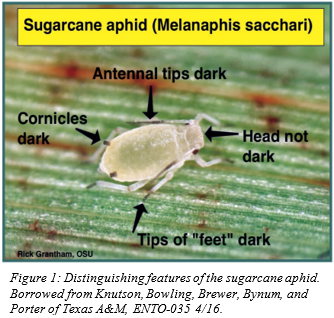Last year many forage sorghum fields were heavily infested and damaged by Sugarcane Aphid (SCA) (Figure 1) – Melanaphis sacchari – feeding. Most calls came in around early July of 2016 with reports of aphids that were not well controlled using broad spectrum materials such as malathion, chlorpyrifos, or dimethoate. This triggered investigations which confirmed the invasion of the new species of aphid to California.
Based on field research and extension material from the US states in the South and Southwest, some basic guidelines for spotting, scouting, and treating SCA can be outlined for potential best management practices in our CA forage sorghum production system.
Identification: The SCA is distinguishable from the greenbug aphid – Schizaphis graminum – by the color of its body and cornicles, or “tailpipes” (Figure 2). The sugarcane aphid nymph body tends to be yellow to orange with black cornicles. Tips of the legs and antennae are also colored black. SCA can be found on the underside of leaves protected from direct sunlight. SCA and Greenbug are known to co-infest sorghum. It's unclear what initial infestation patterns within a field are, so scouting throughout the field – as opposed to only edges – until the insect is found is the best possible practice for now.
Hosts: SCA will infest, feed, and reproduce on sorghum, sorghum-Sudan hybrids, Sudangrass, and Johnsongrass. It will not feed and reproduce on corn or small grains.
Damage: SCA feed by piercing and sucking phloem sap. Removal of photosynthates from the plant cause stunting, desiccation or early senescence of leaves, delayed or reduced grain fill, and even plant death. Additionally, honeydew – excrement from aphids – deposited on leaves will support the growth of sooty mold which will block sunlight from reaching leaves, further reducing photosynthetic efficiency of the plants. A small sample size (n = 16) of silage sorghum sampled at harvest from dairies in the Southern San Joaquin Valley in 2016 as part of Merced Dairy Advisor Jennifer Heguy's research revealed some significant differences in feed value. Of the 16 dairies, 6 had no SCA observed and 10 were infested with SCA. Nutrient analysis of the harvest revealed that crude protein was significantly increased, acid detergent fiber was significantly increased, ash was significantly increased, starch was significantly decreased, and non-fibrous carbohydrates were significantly decreased in harvests where the SCA were present. For more information on this study, visit http://cestanislaus.ucanr.edu/files/258564.pdf to view the full presentation. Growers should consider the potential loss in feed quality of sorghum from SCA infestation when making pest management decisions.
Scouting: When plants reach the 4-5 leaf stage, begin scouting once per week. Choose four locations in the field, at least 25 feet from a field edge, and sample plants along a 50 foot transect into the field. The presence of honeydew is a good indicator of aphid presence. At each sampling location, examine the underside of upper and lower green leaves of 15 to 20 plants. When SCA are detected, begin scouting twice per week until a treatment threshold is reached. It is prudent to also examine nearby locations known to host Johnsongrass for SCA presence.
Treatment threshold: Two established treatment thresholds exist that were developed for grain sorghum in Texas. The most conservative of the two is described here and is recommended for the interim since no research information currently exists on the potential economic damage of SCA to forage sorghum. These are the modified steps to determine insecticide treatment timing:
- Select 5 random plants from each of 4 sampling locations.
- Examine an upper and lower green leaf from each plant (40 leaves total), and estimate the total number of aphids on each leaf.
- Calculate the average number of aphids per leaf (total aphids counted / 40 leaves = average aphids / leaf).
- When the average number of aphids per leaf reaches 50, treatment should generally be made within a week.
This treatment threshold is especially conservative considering research shows that SCA infestation at early stages of sorghum growth are more damaging to yield than infestations at later stages when left untreated. So, it's also advisable to consider infestation timing in crop time to decide whether an early harvest to avoid excessive losses is more cost effective than an insecticide treatment.
Insecticide treatment options: A significant number of CA sorghum growers have opted to purchase insecticide treated seed for the 2017 growing season. Imidacloprid or clothianidin coated seed have been shown to offer protection for up to 40 days after planting. This tactic will probably offer the greatest protection to later planted sorghum, but seed treatment for any planting date is not discouraged since infestation timing is not well understood in CA yet.
For in-season insecticide treatment, the University of CA Cooperative Extension is discouraging the use of broad spectrum materials such as malathion, dimethoate, or chlorphyrifos to control SCA. Of the two insecticides that have shown acceptable efficacy in SCA control in sorghum – flupyradifuron and sulfoxaflor – only flupyradifuron is registered for use on sorghum in CA. Always consult the specimen label for use requirements and a Pest Control Advisor for advice and recommendations when considering an insecticide treatment.
Cultural control options: Cultural practices that promote plant health and vigor will provide a strong basis of control against SCA. Early planting in adequate moisture when soil temperatures are at least 60 degrees F at a targeted population of 100,000 plants/acre is highly recommended. Control weeds, especially Johnsongrass, to promote early plant vigor. Consult a seed dealer for information on SCA tolerant or resistant varieties of sorghum. Research has shown significant grain yield protection exists from planting SCA resistant varieties. Maintain adequate fertility and soil moisture to avoid nutrient deficiencies and drought stress.
Local resources: For more information on SCA and sorghum production, visit http://cestanislaus.ucanr.edu/Agriculture/Dairy_Science/Sorghum_Silage_for_California_Dairies_2017/.
For general information on SCA, visit http://www.sorghumcheckoff.com/newsroom/2016/03/28/sugarcane-aphid/.
For information on sorghum varieties, nutrient, and water requirements, visit http://sorghum.ucanr.edu/.
